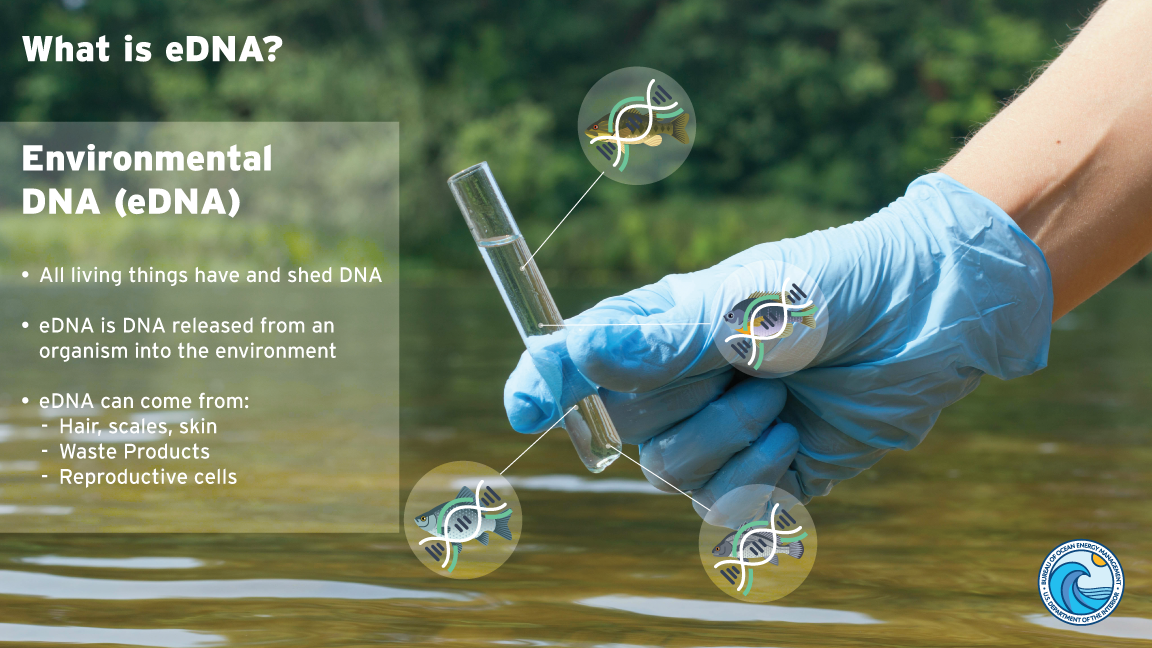
Developing a National eDNA Strategy
Many state and federal agencies already
employ eDNA detection in a variety of
mission applications. However, their
sampling, analyzing, and reporting
methodologies vary considerably. To
ensure agencies are using consistent,
reliable, and credible data, White House
Office of Science and Technology Policy
commissioned a group of agencies to
develop a National Aquatic eDNA Strategy.
Released in June 2024, the strategy will
provide a pathway for federal agencies
to build a coordinated and effective
national eDNA guidance. It outlines a
pathway to promote robust guidelines
for eDNA standards and approaches and
unified strategies to enhance scientific
understanding.
BOEM staff participated on the strategy’s
eDNA task team, providing subject matter
expertise during strategy development.
Just as investigators use trace amounts of genetic material (like DNA) left at a crime scene to help identify suspects, scientists are now using environmental DNA (eDNA) to discover which species have been in an ecosystem.
Like terrestrial organisms, marine species constantly shed genetic material – hair, skin cells, scales, waste products, even dead tissue – into the environment. This is called aquatic eDNA. In the ocean, scientists collect and analyze water samples, which contain biomolecules of all the organisms that live in the area. Using a complex process called metabarcoding, scientists can analyze specific genetic sequences to identify the presence of multiple species – a genetic fingerprint/snapshot of the ecosystem, ranging from microbes to whales.
Integrating ocean-scale biomonitoring using eDNA, passive acoustics, satellite data, ship-based surveys, and aerial observations provides a comprehensive approach to understanding marine ecosystems. eDNA analysis reveals the presence and diversity of species through genetic traces in water samples. Passive acoustics capture vocalizations of marine mammals and fish, offering insights into their behavior and communication. Satellite data, such as ocean temperature and chlorophyll concentration, helps identify areas of high productivity and potential species hotspots. Ship-based surveys and aerial observations complement these technologies by providing visual confirmation of species presence and abundance. By combining these diverse data sources, scientists can gain a more holistic understanding of marine biodiversity, ecosystem dynamics, and the impacts of human activities on ocean health.
Using eDNA has many benefits, including:
- Non-Invasive Monitoring: Traditional monitoring methods for marine species often involve nets, trawls, or visual surveys. eDNA analysis eliminates the need for direct capture or observation, minimizing disturbances to sensitive ecosystems and species.
- Enhanced Detection: eDNA can detect species that are rare, elusive, or difficult to observe with traditional methods. It can even potentially pick up the presence of endangered or invasive species early on.
- Improved Ecosystem Understanding: eDNA provides a comprehensive picture of biodiversity in an area by allowing for multi-species and multi-trophic approach to data collection. It can even reveal the presence of microorganisms, giving a fuller picture of the ecosystem's health.
- Broad-Scale and Cost Effective: eDNA analysis allows for large-scale monitoring across vast marine areas. Over time, it can prove more cost-effective than deploying vessels and researchers for physical surveys.
- Monitoring Change: BOEM needs to understand how energy projects affect marine environments. eDNA analysis can establish baseline biodiversity data and track changes over time related to human activities or other environmental shifts.
eDNA and BOEM
BOEM’s Environmental Studies Program (ESP) recognizes the benefits an eDNA can provide to ensure the bureau has the best available science to inform its decision making. eDNA can help inform BOEM’s decision making for:
- Offshore Wind Development: eDNA can assess the pre- and post-construction biodiversity around wind farms, aiding in the analysis of potential impacts on marine life.
- Monitoring Protected Areas: eDNA can help monitor the effectiveness of marine protected areas, ensuring they harbor the target species.
- Oil Spill Response: In the event of an oil spill, eDNA can help track changes in biodiversity and identify areas most affected, guiding remediation efforts.
Of course, like any technology, eDNA has limitations. eDNA indicates the presence of a species' DNA, not the live organism itself. Understanding population size or behavior can require additional research. Also, eDNA’s effectiveness depends on robust reference databases of DNA sequences to accurately identify species. Working with the Smithsonian Institution’s Museum of Natural History, BOEM is cataloging and bar-coding DNA from the organizations’ joint marine invertebrate collection to create a genetic reference library. Scientists match eDNA samples against this library for species identification.
-- BOEM --
The Department of the Interior’s Bureau of Ocean Energy Management (BOEM) manages development of U.S. Outer Continental Shelf (OCS) energy, mineral, and geological resources in an environmentally and economically responsible way.


